Porcelain Insulator News
by Elton Gish
Reprinted from "Crown Jewels of the Wire", November 1994, page 25
There has been a tremendous response to my new book, Fred M. Locke: A
Biography. There is a sufficient quantity of the soft cover edition but only 87
volumes of the hard cover edition were produced. Advance orders for the limited
hard cover edition were shipped about August 7th. By the time you read this in CJ, all hard cover books probably will have been sold. Many of the hard cover
books were shipped to the Victor area to interested people, libraries, and
historical societies, and a large number were given to the five Fred Locke
granddaughters and immediate families in recognition of their help. Only 45
copies were obtained by collectors. So, if you were fortunate enough to get a
hard cover edition, it should prove to be a good investment for the future. See
my ad in the back of this issue of Crown Jewels of the Wire to order the 343
page, 8-1/2" x 11" size soft bound edition, which incidentally weighs
in at three pounds.
My next project was prompted by many of you who have
requested a value guide for porcelain insulators. Interest in porcelain
insulators has been increasing over the last two years. Interest in collecting
multipart porcelain insulators has been especially brisk. So, I have started to
put together a value guide for both unipart and multipart porcelain insulators
with the goal of having it available at the 1996 National Show in Marlborough,
MA. My list of known multipart specimens is fairly up-to-date but I need help
putting together a comprehensive list of unipart specimens which can be found in
an enormous variety.
To accomplish this task, I have asked twenty-nine avid
porcelain collectors to catalog their collection. I sent them a preliminary list
itemizing U-number, manufacturer, and color. Seven people, have already returned
the survey which added about 50% more 'insulators to the survey -- almost 1800
different unipart specimens!! After all the surveys have been returned, a final listing will be sent back to them asking
for values. The end result should be a fairly good average value for each
insulator as well as a general survey of the quantity of rarer specimens.
Everyone who has sent back their survey has expressed excitement over the
project and are very willing to help. This is a tedious job for each collector
and the importance of everyone participating cannot be looked on lightly.
Now is
a good opportunity to expand on Jack Tod's 1975 survey of rare to uncommon
specimens. His survey offered an insight into how many rare specimens were
available, but a lot has changed over the past 19 years. If you would like to
participate in the survey of known specimens and inventory of rare specimens,
please send me a request and I will mail you a copy of the 36 page survey. OR
simply send me a listing of what you have in your collection and I will add it
to the survey. It is important that we get a reasonably good inventory of rarer
items and as complete a listing of specimens as possible. I cannot afford to
spend several years traveling around the country to shows and collections to
compile a list of known unipart specimens.
Please do not feel that your
collection is too small or too common to be included. Chances are that you have
at least one item that is considered interesting, uncommon, or rare, has not
been seen before in that color, and/or the manufacturer/marking is unusual for
that style. Every collection that I have seen has at least one item (and usually
many more) that fit in one of those categories. If you do send in your
inventory, I will place your name on the mailing list to be the first to receive
notice of the new "Porcelain Insulator Value Guide: For Unipart and
Multipart Insulators".
Now for reports of new items. It seems that news of rare porcelain insulators
continues to surface each year. This year is no exception and may be one of the
best years in a long time for new reports. Steve Jones (NIA #5426) and Ken
Willick (NIA #3709) are fascinated with the historic 26-mile, 11,000 volt
Niagara Falls-Buffalo transmission line in western New York. They have spent
many hours walking the line and digging in various dumps in the area. The
original line was put into service on November 16, 1896 using Fred Locke's
design for U-937 which he had produced by Imperial Porcelain Works of Trenton,
NJ. Imperial could not produce a sufficient quantity of the oval-shaped U-937 to
complete the line on schedule so they made up the balance with Imperial made
U-934's. I suspect that Imperial was having problems pressing out an oval
insulator and got permission to change the design to the round U-934.
Specimens of U-937 are particularly rare and desirable (one
specimen is in the Smithsonian). A slightly greater quantity of the U-934 style
has been found associated with that line and a small number were found in
British Columbia during the last couple of years, so the U-934 is rare, too.
Trade journals referred to U-937 as "Niagara Type" and U-934 as
"Type C". More details of the Niagara Falls-Buffalo line, historical
references, and photographs can be found in my new book, Fred M. Locke: A
Biography.
In late 1900, work was begun to install a second pole line that would
operate at 22,000 volts. The pole spacing of the original pole line was only 70
feet in anticipation of a build up of heavy layers of ice. The ice was never a
problem because heat generated by the line prevented it from forming. So the
pole spacing of the new line was increased to 140 feet. To accommodate the
higher voltage and anticipated additional strain of a longer pole spacing, a
larger insulator was designed with a 1-5/8" inch pin. This was U-966 as
designed by Lewis B. Stillwell. He was a resident of Niagara Falls and probably
worked for the Niagara Falls Power Co. Stillwell applied for the design patent
on Dec. 18, 1900, and design patent No. 34,211 was granted on March 12, 1901.
This unique insulator was called "Type E" and originally manufactured
by the R. Thomas & Sons Co. The Thomas version is U-966 and can be found in
their 1904 catalog. Two similar styles, U-966A (made by the New Lexington High
Voltage Porcelain Co.) and U-966B (made by the Imperial Porcelain Works), were
copies of the Thomas "Type E".
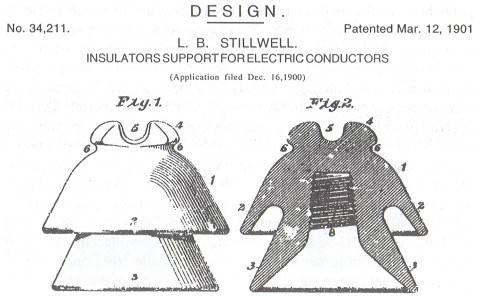
The New Lexington version, U-966A, is very rare. A few of them have the
marking "NEW LEXINGTON, O." on the side of the crown. I have not seen
any evidence to indicate where these were used. Both the Thomas U-966 and New
Lexington U-966A were made of two pieces fused together by glazewelding. There
are more specimens of U-966 than any other "Type E" style, but it is
still considered rare. No specimens of U-966 are marked. I have heard of only
two specimens that were marked "THOMAS", but these were the cemented
version, M-2275 (7 - 6.5 x 8). M-2275 is the same basic shape as U-966 except
that the two parts are cemented together instead of glazewelded. A few U-966's
have been found on the upper Michigan peninsula in the iron ore regions. I have
not heard of any evidence to suggest that M-2275 was found along the Niagara
line.
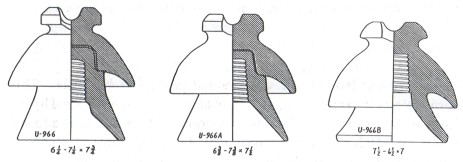
Unfortunately, when my book, Fred M. Locke: A Biography, was published, we
did not have a specimen large enough to assign a new U-number, so I called it
U-966A. This leads us back to Ken and Steve's exploration of the Niagara
Falls-Buffalo power line. Ken has occasionally found broken specimens of the
Imperial "Type E" along the line right-of-way (see January 1992 CJ).
Earlier this year Ken and Steve were extremely fortunate to find several nice
brown Imperial "Type E" specimens in two small piles along the line.
The Imperial version was quite different and I assigned it U-966B. All of them
have the Imperial "crown logo" with manufacturing dates but the heavy
brown glaze makes the markings mostly unreadable. However, Ken got one mint
specimen with a lighter glaze that shows the manufacturing date to be
"6-7-001" (1901). Since the second line was put into service on April
1, 1901, the Imperial U-966B' s were probably used as replacements. What makes
U-966B more unusual is that it was made from one piece of porcelain -- not glaze
welded! This is not surprising for those of you that have already read my book,
because you would have learned that Imperial never made glazeweld insulators. U-966B is very rare. Before Ken
and Steve's discovery, only one specimen was known, and that one has not been
seen for many years.

Four of the brown U-966B Imperials found
along the Niagara Falls-Buffalo
line.
Richard Brennan wrote me about a recent discovery of the super rare Thomas
classic U-976. Richard found a beautiful specimen at a flea market. It has a
very light caramel-colored glaze with some darker mottling. This is the third
specimen known. We first reported this style in the January 1991 CJ. Specimens
of U-976 were made from two pieces glazewelded together. They have the
characteristic Thomas "blue-jean" seam inside the bottom skirt and
clear impressions of the weave of denim fabric. I think the denim was used to
prevent the plunger from sticking to the soft clay when it was removed after
forming the shape of the skirt. The near vertical sides of the skirt would make
the plunger difficult to remove without pulling the clay apart. The 1904 Thomas
catalog showed U-967 as No.8 "S" (2-part).
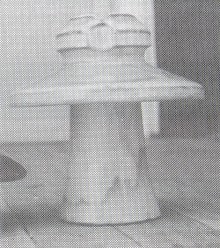
Thomas U-976 |
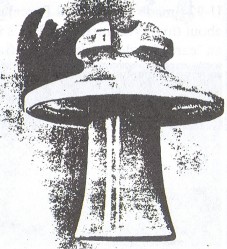
No.8 "S" (U-976)
from 1904 Thomas catalog |
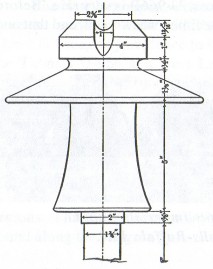
Illustration of Thomas No.9 "S"
from January 21, 1905 Electrical
World and Engineer.
All three of the U-967 specimens apparently were found in the New York area,
but I have not been able to locate an old trade journal article describing their
use. I did find an article in the January 21, 1905 issue of Electrical World and
Engineer that described the use of a slightly larger Thomas No. 9 "S".
It was the same style and height as U-967 but the top skirt was 9 inches in
diameter (Thomas catalog shows the diameter of No. 8 "S" to be 8
inches). This larger insulator was used on two 34-mile, 22,500 volt transmission
lines from the power house at DeCew Falls, Ontario to Hamilton, Ontario. One
line ran along the shore of Lake Ontario and the second line ran parallel to the
first a few miles from the shore and above the escarpment. The water used in the
hydroelectric project was diverted from Lake Erie by the WeIland Canal. The
article stated that the power company intended to increase the line voltage to
45,000 which may have required larger insulators. Maybe one of you in that area
can track down the Thomas No.9 "S".
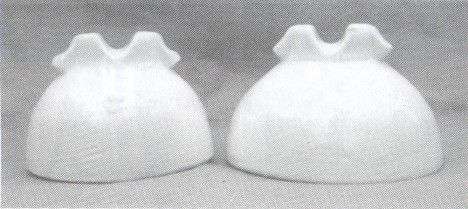
Imperial U-924 (left) and U-930 (right)
The next unusual insulator is one I
recently acquired. It is a white U-924 made by Imperial Porcelain Works. Nothing
has been written about this style since Jack Tod's first report in May 1973 CJ.
U-924 is an "eared" style similar to Imperial's white U-930, Fred
Locke's under-glaze ink marked U-925 made by Electric Porcelain & Mfg. Co., Fred
Locke's Victor made incuse marked U-925, and U-929 which was made in the few
years after Fred Locke "retired" 'in 1904. U-924 and U-930 were
probably made between the summer of 1896 and July 1, 1897 because they do not
have the Imperial "crown logo". Each bear the incuse marking,
"MANUFACTURED BY / IMPERIAL PORCELAIN WORKS / TRENTON, N.J.". The ears
on the two Imperial styles are a hefty 1-1/4 inches wide. The ears on the
various Fred Locke styles are consistently a meager 5/8 of an inch wide, which
makes them much more likely to be chipped and broken. I cannot understand why no
one at Locke thought to make the ears wider since they are the only thing
keeping the tie-wire in place. Imperial obviously developed the
"eared" design first and Fred Locke copied it. Specimens of U-924 and
U-930 are rare and very worthy of adding to your collection.
|
